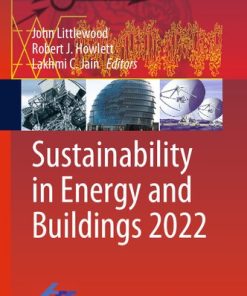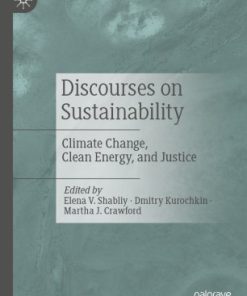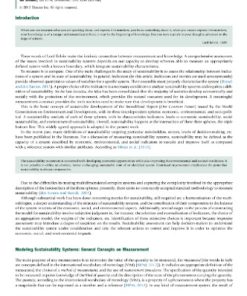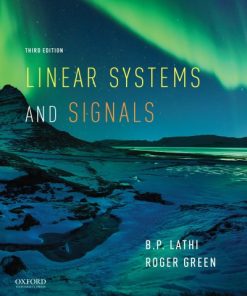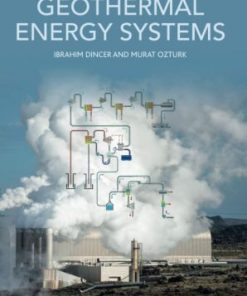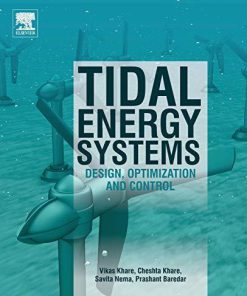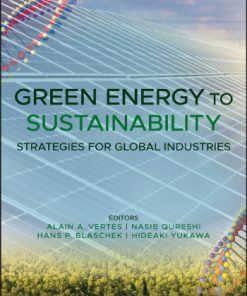(Ebook PDF) Energy Systems and Sustainability 3rd Edition by Bob Everett, Stephen Peake, James Warren 0192608940 9780192608949 full chapters
$50.00 Original price was: $50.00.$25.00Current price is: $25.00.
Energy Systems and Sustainability 3rd Edition by Bob Everett, Stephen Peake, James Warren – Ebook PDF Instant Download/DeliveryISBN: 0192608940, 9780192608949
Full dowload Energy Systems and Sustainability 3rd Edition after payment.

Product details:
ISBN-10 : 0192608940
ISBN-13 : 9780192608949
Author: Bob Everett, Stephen Peake, James Warren
Energy Systems and Sustainability provides an exploration of the economic, social, environmental, and policy issues raised by current systems of energy use, as well as describing their key physical and engineering features. From an overview of the historical evolution of the world’s energy systems, through the principles underlying their use, to future prospects and sustainability, this comprehensive text provides thorough coverage of contemporary energy conversion systems and their impact on society and the environment. The engaging writing style and frequent use of illustrations makes the text accessible for students of all backgrounds and levels.
Energy Systems and Sustainability 3rd Table of contents:
Chapter 1 Introducing energy systems and sustainability
1.1 Introduction
1.2 What is an ‘energy system’?
1.3 The present global energy system
Fossil fuels
Nuclear energy
Renewable energy sources
1.4 What is a sustainable energy system?
1.5 Why sustainable energy matters
Growthist: ‘business as usual’
Peakist: fossil fuels limit growth
Global distribution of fossil fuel reserves
Peak uranium?
Environmentalist: global environment limits growth
Nuclear safety
Three perspectives: a summary
1.6 How can we achieve the transition to low-carbon energy systems?
Using energy more efficiently
Reducing CO2 emissions from fossil-fuelled technologies
Switching to renewable and/or nuclear energy sources
Changing patterns of UK energy use
1.7 Summary
Key points
References
Chapter 2 Primary energy
2.1 Introduction
2.2 Consuming energy
What is energy consumption?
What is primary energy?
‘Energy arithmetic’
Energy and power
Watts
Kilowatt-hours
2.3 Quantities of energy
Units based on oil
Units based on coal
The BTU and related units
The calorie and related units
2.4 Interpreting the data
Definitions
Conversions
Conventions
2.5 World primary energy sources
World renewable energy
International comparisons
2.6 Primary energy in the UK
The UK’s changing energy scene
Renewables in the UK
2.7 Primary energy in Denmark
Renewables in Denmark
2.8 Primary energy in the USA
Renewables in the USA
2.9 Other countries of interest
France
India
Biomass in India
China
2.10 Summary
Key points
References
Chapter 3 What do we use energy for?
3.1 Introduction
3.2 Primary, final and useful energy
3.3 The expanding uses of energy
Food
Fertilizers
Farm mechanization
Domestic energy
Heating, washing and cooking
Preserving and processing food
Lighting
Industry
Physical labour
Iron and steel manufacture
Aluminium smelting
Processes that need high-temperature heat
Transport
Services
3.4 UK energy uses today
UK electricity conversion losses
Trends in UK energy consumption
3.5 International comparisons
Energy and GDP
More and more electricity
More and more travel
UK and Denmark
USA
France
India
China
3.6 Summary
Key points
References
Chapter 4 Forms of energy
4.1 Introduction
4.2 Kinetic and potential energy
4.3 Heat
4.4 Electrical energy
Electrons
Electrical circuits
Current
Voltage
Resistance
Electric power
4.5 Electromagnetic radiation
4.6 Chemical energy
The chemical elements
Using chemical energy
The nuclear atom
Isotopes
The energy
4.7 Beyond chemistry
The nuclear force
Mass and energy
4.8 Summary
The essentials
Key points
In conclusion
References
Chapter 5 Coal
5.1 Introduction
5.2 From wood to coal
The early years
The Industrial Revolution
The 19th century
5.3 The nature of coal
Types of coal
Composition of coal
The combustion process
Proximate analysis
Combustion products
5.4 Uses of coal
The 19th century gasworks
Modern coke production
Smokeless fuels
Coal for electricity
5.5 The coal resource
Mining the coal
Deep mines
Surface mines
Resources, reserves and production
Coal in the USA
Coal in China
Coal in Russia
Coal in India
Coal in Australia
The UK’s shrinking coal industry
5.6 Fires, furnaces and boilers
Power station boilers
Grate boilers
Pulverized fuel boilers
Fluidized bed boilers
Flue gases
Reducing particulate matter
Reducing SO2 emissions
Reducing NOx emissions
Disposing of the ash
5.7 Is there a future for coal?
5.8 Summary
Key points
References
Chapter 6 Heat to motive power
6.1 Introduction
6.2 Steam engines
The early years
James Watt
6.3 The principles of heat engines
Carnot’s law
The Carnot engine
The laws of thermodynamics
Atoms in motion
Heat flow
6.4 The age of steam
Improving the efficiency
Mobile power
Trains
Ships
6.5 Steam turbines
Steam, speed and rpm
Parsons’ turbo-generator
Marine engines
6.6 Power station turbine systems
The turbines
Turbine systems
Steam pressures
The boiler
The condenser
Materials
6.7 Flows in a 660 MW turbine system
The feedwater pump
The boiler
The turbines
The condenser
Efficiency
6.8 The future
6.9 Summary
Key points
Early steam engines
The Three Laws of Thermodynamics
Steam turbines
Steam turbine power station cycle
References
Further reading
Chapter 7 Oil and gas
7.1 Introduction
7.2 The origins and geology of petroleum
7.3 The start of the oil and gas industries
Petroleum for illumination
Petroleum for transport
The natural gas industry
7.4 Finding and producing petroleum
Oil prospecting
Production
7.5 Oil refining and products
Getting more of what you want
7.6 Oil today
Reserves and production
The changing pattern of UK oil use
7.7 Natural gas
An energy revolution in the UK
Global gas reserves and production
The future prospects for gas in the UK
7.8 The rise and fall of North Sea oil and gas
7.9 Why are oil and gas so special?
High energy density – clean to burn
Convenient and easy to use
Ease of distribution, storage and portability
Readily available and (for the moment) cheap
7.10 Conversion technologies
Town gas from oil
Synthetic natural gas (SNG) from coal
Coal to liquids (CTL)
Removing carbon
Adding hydrogen – direct liquefaction
Adding hydrogen – the Sasol process
Gas to liquids (GTL)
Jet fuel and syngas from biomass
7.11 Unconventional oil and gas
Heavy oil and extra-heavy oil
Oil shales
Oil or tar sands
Tight oil and gas
Coal bed methane (CBM)
Methane hydrates
7.12 Peak oil or peak demand?
Hubbert’s shocking scenario
Has tight oil proved him wrong?
First the USA … now the world
What is the future for natural gas?
Will climate change produce ‘peak oil demand’?
7.13 Summary
Key points
References
Further reading
Chapter 8 Oil and gas engines
8.1 Introduction
8.2 The petrol or spark ignition engine
The birth of the car engine
The motorization of the USA
Aircraft petrol engines
Compression ratio and octane number
Lead additives
Alternative fuels
8.3 The diesel or compression ignition engine
Diesel power for ships
Diesel engines for road, rail and air
DERV
Biodiesel
8.4 Petrol and diesel engines – reducing pollution
Emissions from petrol engines
The lean-burn engine
The 3-way catalytic converter
Emissions from diesel engines
Obtaining best efficiency
8.5 The gas turbine
Two rival jet engines
Post-war developments
Modern jet engines
Industrial gas turbines
Gas turbines for cars?
Improving efficiency and CO2 emissions
8.6 The Stirling engine
Principles
The Philips engine
8.7 Which is the best engine?
8.8 Summary
Key points
Petrol and diesel engines
The gas turbine
References
Further reading
Chapter 9 Electricity
9.1 Introduction
9.2 Making electricity in the 19th century
Batteries and chemical electricity
Magnetism and generators
The telegraph
The rise of electric lighting and mains electricity
AC or DC?
High voltage or low voltage?
Simple metering and tariffs
9.3 The continuing development of electric lighting
Improving the incandescent light bulb
The fluorescent lamp
The light-emitting diode (LED)
Efficacy and colour rendering index
Pollution problems – the end of the incandescent?
9.4 Electric traction
Electric trams and trains
Battery electric vehicles
Electric transmissions and hybrid electric drives
9.5 Expanding uses
Telecommunications and computers
Cooking and heating
Refrigeration
Electric motors everywhere
Where electricity is used in the UK today
9.6 Large-scale generation
Competition versus economies of scale
Hydroelectricity
New fuels
The development of the CCGT and the UK dash for gas
The rise of renewable energy
Combined Heat and Power (CHP) generation
Small-scale CHP
Large-scale CHP with community heating
9.7 Transmission and distribution
The National Grid in the 1930s
Coal by wire
The Supergrid
The UK grid today
International links
9.8 Running the system
Four tasks
What exactly is being optimized?
Ownership of the system
Balancing supply and demand
Peak demands and pumped storage
Coping with the variability of renewable energy
Smart meters and smart grids
9.9 Electricity around the world
UK
USA
France
Denmark
India
China
9.10 Summary
Key points
Electricity generation and transmission
Electricity has many uses
References
Further reading
Chapter 10 Nuclear power
10.1 Introduction
Nuclear power worldwide
10.2 Nuclei: a brief summary
10.3 Radioactivity
Alpha particles
Beta particles
Gamma radiation
Radioactive decay and half-life
An effect without a cause
10.4 Nuclear fission
Experiments with neutrons
Fission
1939–1945: reactors and bombs
The first reactor
New fissile nuclei
Atomic bombs
‘Swords into ploughshares’
10.5 Thermal fission reactors
The reactor
Fuel
Moderator
Coolant
Control system
Safety
Structures
Shielding
Containment
Accidents
Passive response
Thermal efficiency
10.6 Types of thermal fission reactor
Light water reactors
Pressurized water reactors
Boiling water reactors
Gas-cooled reactors
Heavy water reactors
RBMK reactors
Summary of reactor types
10.7 The nuclear fuel cycle
Mining and extraction
Enrichment and fuel fabrication
Spent fuel
Direct disposal
Reprocessing
10.8 Fast neutron reactors
Liquid metal fast breeder reactors
Safety
10.9 Power from fusion
10.10 Summary
Key points
References
Further reading
Chapter 11 The future of nuclear power
11.1 Introduction
11.2 The current state of play
Favourable pressures
National energy security
Need for low-carbon energy sources
Unfavourable pressures
Economic pressures
Free markets and privatized electricity systems
Capital costs
Cheap fossil-fuel-based electricity
Safety
Nuclear waste
Future uranium supplies
Nuclear proliferation and terrorism
11.3 The uranium resource
Availability of uranium ore
Energy return on investment
11.4 Solutions to possible uranium limitations
‘Secondary’ sources of uranium
Re-enrichment of existing ‘depleted uranium’ tails
Highly enriched uranium (HEU)
Uranium recovered from reprocessing
Using mixed oxide fuel (MOX)
Recycling PWR fuel into CANDUs
‘Enhanced burn-up’ in light water reactors
11.5 Nuclear power and safety
11.6 Waste disposal and decommissioning
Waste and the nuclear fuel cycle
Long-term waste storage
Plant decommissioning
11.7 Generation costs and the prospects for cheaper nuclear power
The factors determining generation cost
Reducing nuclear costs
Small modular reactors
High-temperature and advanced modular reactors
11.8 Beyond the basic open fuel cycle
Closing the fuel cycle – reprocessing
Nuclear proliferation issues
Uranium enrichment plants
Reprocessing plants
Plutonium production in fast breeder reactors
Breeding uranium from thorium
Nuclear fusion
11.9 A nuclear renaissance? Conflicting views
11.10 Summary
Key points
References
Chapter 12 Costing energy
12.1 Introduction
12.2 Energy prices today
Petrol and diesel fuel
Domestic energy prices
Industrial energy prices
12.3 Inflation, ‘real’ prices and affordability
The value of money
Affordability and fuel poverty
12.4 Investing in energy
Price and cost
Balancing investment against cash flow
Choosing a light bulb
Assessing a power plant
Discounted cash flow analysis
Interest rates and discount rates
Project lifetime
Basic discounting formulae
Present value
Net present value
Annuitization
A discounted cash flow calculation in detail
Assessing financial risk
Perceived risk in electricity generation
Wider acceptable discount rates and investment lifetimes
The private individual
Commercial companies
Intergenerational equity
Discounted cash flow – summary
12.5 Real-world complications
Energy security and diversity of supply
Imbalances between energy supply and demand
Tackling air pollution
Encouraging energy efficiency with fuel taxes
New energy technologies and economies of scale
Financial mechanisms for support
Resulting price reductions
12.6 Summary
Key points
Fuel prices
Inflation, ‘real prices’ and affordability
Investing in energy
Discounted cash flow
Encouraging energy conservation
New energy technologies and economies of scale
References
Chapter 13 Penalties: assessing the environmental and health impacts of energy use
13.1 Introduction
13.2 Climate change
The human perturbation of the carbon cycle
Other greenhouse gases
Factors in global warming
The present effects of anthropogenic climate change
The future consequences of climate change
Progress in reducing greenhouse gas emissions
13.3 Air-quality-related impacts
Forms of airborne pollution
Wood burning in developing countries
The effects of acid rain
Particulates
Progress in reducing air pollution
Developed countries
Developing countries
13.4 Classifying the impacts of energy use
By scale
By source
By public concern
13.5 The full financial costs of energy use
Energy subsidies
The external costs of energy use
Economic valuation of impacts
Fuel chain analysis
The impact–pathway approach
Damage costs for non-climate-related pollution
Climate-related damage: the social cost of carbon
Market-based carbon pricing: ‘cap and trade’
Using damage costs to evaluate technologies
The external costs of coal-fired electricity
Comparing the overall costs of different electricity generation technologies
Assessing the benefits of improved diesel vehicle standards
13.6 Nuclear power: radiation impacts of routine operation
Public impacts
Workplace impacts
13.7 Accidents across fuel chains
Coal
Oil and gas
Hydro power
Wind power
Biomass harvesting and forestry
Nuclear power
13.8 Energy return on investment (EROI)
EROI of electricity generation
Liquid fuels
Future EROI for fossil fuels
13.9 Land requirements
13.10 Summary
Key points
Climate change
Air-quality-related impacts
Classifying the impacts of energy use
The full financial costs of energy use
Nuclear power: radiation impacts of routine operation
Accidents across fuel chains
Energy return on investment (EROI)
Land requirements
References
Chapter 14 Remedies: towards a sustainable energy future
14.1 Introduction
14.2 Cleaning up fossil fuels
Low-level air pollution
Particulates
Sulfur dioxide
Nitrogen oxides
Reducing carbon dioxide emissions
Fossil fuel switching
Improving coal-fuelled electricity generation efficiency
Carbon capture and storage (CCS)
Capturing the CO2
Post-combustion capture
Pre-combustion capture
Gathering and transporting the CO2
Final CO2 storage
CO2 storage potential
A working system?
Costs
14.3 Carbon dioxide removal
Reforestation
Bioenergy with carbon capture and storage
Direct air capture (DAC)
14.4 Reducing energy demand
Saving space heating energy
The transport sector
Social changes
Technological measures
14.5 Harnessing renewable energy
Solar energy
Solar thermal heating systems
Solar photovoltaics (PV)
Concentrated solar power (CSP)
Indirect use of solar energy
Bioenergy
Traditional biomass
Modern biomass
Biofuels
Hydroelectricity
Wind energy
Wave power
Non-solar renewable energy
Tidal energy
Tidal barrages
Tidal stream devices
Deep geothermal energy
Heat gains from heat pumps
The sustainability of renewable energy
14.6 Increased use of nuclear power
14.7 Hydrogen: the fuel of the future?
Producing hydrogen
Hydrogen from fossil fuels
Green hydrogen from renewable energy
Properties of hydrogen
Hydrogen storage
Hydrogen transmission
Using hydrogen
Mixing hydrogen with natural gas in the existing grid
Acorn CCS project
Fuel cells
Fuel cell applications
A full hydrogen economy
14.8 Towards a sustainable world energy future
Tackling climate change
Climate change policy in the UK
The CAT Zero Carbon Britain scenario
Scenarios for future world energy use
IEA business as usual scenario
IEA Sustainable Development Scenario
Teske 1.5 °C scenario
The effects of the Covid-19 pandemic
Change and investment
Signs of change?
14.9 Summary
Key points
Cleaning up fossil fuels
Carbon dioxide removal (CDR)
Reducing energy demand
Harnessing renewable energy
Nuclear power
Hydrogen
People also search for Energy Systems and Sustainability 3rd:
energy systems and sustainability pdf
energy systems and sustainability engineering
energy systems and sustainability power for a sustainable future pdf
energy systems and sustainability everett
energy systems and sustainability boyle pdf
You may also like…
Engineering - Energy & Power Resources
Politics & Philosophy - Government & Politics
Discourses on Sustainability: Climate Change, Clean Energy, and Justice 1st Edition
Reference
Engineering - Telecommunications
Technique - Energy: Renewable Energy
Engineering - Energy & Power Resources
Science (General)




